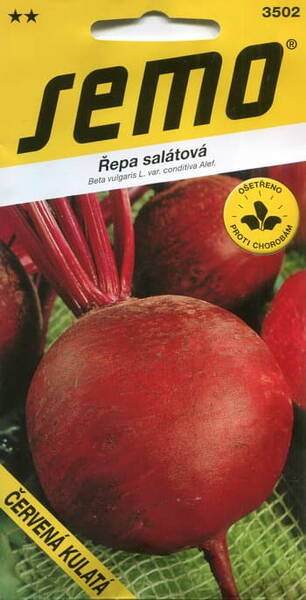Early productive variety. The period from germination to the beginning of economic suitability is 65-90 days.
Root crops are rounded, weighing 220-500 g.
The pulp is juicy, sweet, dark red with a purple tint. No ringing. Taste is high. Good storage quality.
Advantages of the variety: cold-resistant, not prone to flowering. Normally tolerates lack of moisture.
1,0 g = 40-60 seeds.
* Harvesting and storage of beets.
More sugar accumulates in root crops in dry sunny autumn when the nights become cool.
Closer to harvest, watering is stopped, which leads to an intensive accumulation of sugar. But if the autumn is very dry, then a week before harvesting, the plants need to be watered to avoid wilting of the root crops.
Harvesting is carried out in such a way as to prevent them from freezing. This is especially dangerous for varieties with cylindrical roots.
In the middle lane, beets begin to be harvested, depending on the weather (in the third decade of September and earlier). To improve storage conditions, beets are recommended to be piled in a cellar with sand, alternating layers of sand with root crops. The temperature should not fall below zero.
Important: when harvesting, do not cut the leaves too close to the root crop: leave three to six centimetres so that the juice does not flow out.
Signs of nitrogen starvation in plants are slow development, stunting and pale green leaves.
With a lack of phosphorus, growth stops and the formation of the root crop is delayed, the leaves become smaller.
A lack of potassium is indicated by a slowdown in growth, the appearance of spotted browning on the leaves, and death from the top and edges of plants.
With a lack of manganese, black spots are observed on the leaves (mistaken for a disease) and then the leaf plate dies off and twists.
Copper deficiency (on peat soils) causes root rot.
Boron reduces root damage by dry rot.
Top dressing with a 1% solution of table salt increases the sugar content of root crops.
The first feeding is carried out when a pair of leaves appears with mullein, diluted 4-5 times or 8-10 times with bird droppings.
The second - after 2-3 weeks with a solution of wood ash at the rate of 500 g per 10 liters of water.
* Scientific studies have confirmed the high healing properties of red beets.
It has been established that fibre, malic, citric and other biogenic acids contained in beets enhance intestinal motility, betaine promotes the breakdown and absorption of food proteins and is actively involved in the formation of choline, which increases the vital activity of liver cells. Therefore, it is recommended for chronic constipation, digestive disorders and liver diseases to use it boiled on an empty stomach, 100-150 grams per day.
Beet juice, especially when mixed in equal proportions with carrot and radish juice, helps with anaemia, and in general, it is a tonic and improves metabolism. Beet juice mixed with honey is used for hypertension and as a sedative.
The relatively high content of iodine and magnesium makes beets essential in the diet of the elderly and patients suffering from atherosclerosis. But the most amazing effect of red beets on cancer cells.
In the book "Red Beets as an Additional Therapy in Patients with Malignant Tumors", published in Heidelberg, an ancient German university centre, A. Ferenczi describes 28 cases of curing patients with cancer of the stomach, lungs, rectum and bladder with grated raw beets and its juice. All of them, with the exception of one, had objective signs of improvement in their general condition after two to four weeks: a decrease in temperature and ESR, weight gain, an improvement in blood composition, and a decrease or disappearance of a malignant tumour.
Further scientific studies have shown that the basis containing the substance that affects cancer cells are anthocyanins - colouring compounds from the group of plant phenols. It turned out that anthocyanins and other plants - blueberries, black currants, black elderberries, St. John's wort and red wine are also able to stop the development of cancer cells.
True, red beets, according to experiments, are eight times more effective, but since not everyone can tolerate and absorb beetroot juice, other fruits and herbs can be of help in this treatment for anthocyanins. Moreover, in the natural composition - isolated pure anthocyanins, as shown by special studies conducted by the Pharmaceutical Institute in Budapest, do not have healing properties. Both boiled beets and boiled beet juice do not possess them or have too little efficiency. Fresh juice, as it turned out, is three times more effective than stagnant.
To this, we can add the following. Freshly squeezed beetroot juice is good to hold for three hours in the refrigerator, after which it is much better absorbed by the body (of course, after the refrigerator, the juice should be warmed to room temperature).
So, beets are an unusual vegetable with healing properties. Eat more of it boiled, if possible, prepare a salad to which you add fresh beets, drink juice, and you will be insured against many serious diseases.
Beetroot also helps out in case of radiation injuries - it has the ability to remove radioactive substances from the body (boiled beets also retain this ability). Removes red beets from our body and poisons, and heavy metals (the same lead, the same mercury).












